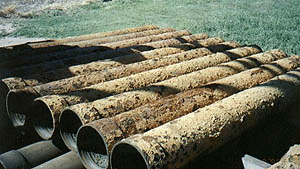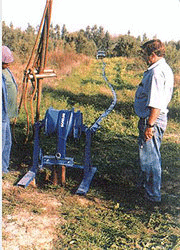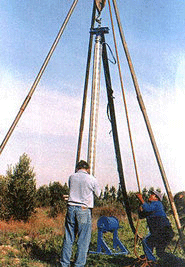Groundwater Extraction
Clean potable water is essential to life, yet so many of the world’s population do not have access to it. Problems faced by developers are very similar, namely the lack of large sources of unpolluted or salt-free raw water and the lack of funds.
Dams and pipelines are a tangible indication of money spent while there is a false perception that it is difficult to quantify volumes of groundwater available in most aquifers. This creates uncertainty and results in less spending and this potentially large supply remaining un-tapped.
Traditionally, steel pipes have been used with submersible pumps to transfer water from the depths of an aquifer to the surface. The water is then used for domestic, agriculture or other uses. There have been many problems associated with these heavy, bulky rigid pipes, but users such as, Water Utilities, Mines, Farmers and others have had no choice but to remain with these products.
Problems faced would begin with transporting the pipes to site as large trucks would be required. Installing the pump and pipe would be another time-consuming exercise as a large crane with lifting gear are needed to lower the pump and pipe into the well or borehole. Pump removal for repair or servicing is just as frustrating.
Boreline®, is a Flexible Rising Main designed to solve many the problems associated with rigid systems. Because of its inherent characteristics, Boreline® rolls up flat thereby making it light and compact and very easy to transport. A small pick-up truck or LDV can be used to transport the Boreline® to site, immediately reducing the extra costs associated with a larger vehicle.
Once on site, the Boreline® is unrolled and attached to the pump using the available Boreline® Couplings. These are available in 304 SS , 316 SS or 904L SS. The power cable is attached to the hose along the entire length using the provided cable straps.
The pump is lifted and lowered into the well. The other end of the Boreline® is placed over a simple rolling wheel and attached to the pick-up. The vehicle is then used to lower the Boreline® into the well in minutes, using only a couple of assistants.
Boreline® has been designed with superior strengths in mind. The result is that the hose itself can support the pump, pipe and water up to a depth of 660ft (200m). No support ropes or cables are required.
Using Boreline® results in immediate cost savings in time and money.
Boreline® also does not corrode or scale internally. The figures for water flow and head losses calculated originally during the design phase are the same figures one gets after years of pumping. Because of its flexibility, the internal scaling which plagues the rigid systems, causing costs of pumping to increase, does not affect the Boreline®.
Removing the pumps for servicing is just as simple, resulting in labour cost savings.



